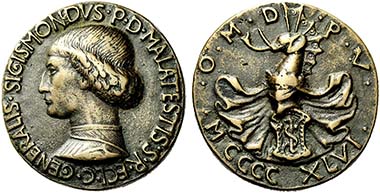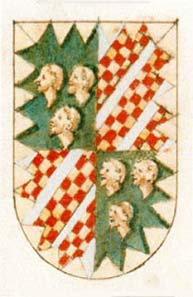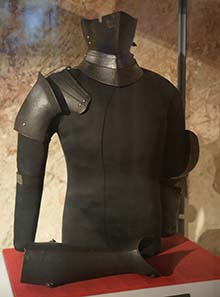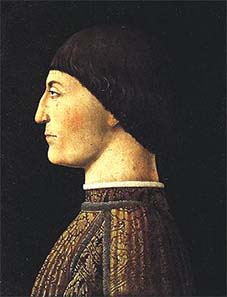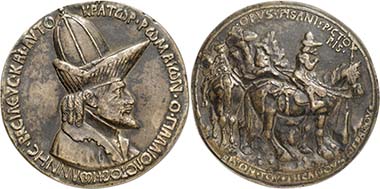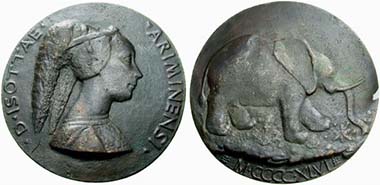In 1462, there was a great fire to be witnessed in Rome: Pope Pius II burnt the effigy of infamous Sigismondo Malatesta, once beloved son and captain-general of the Holy Roman Church. Malatesta, as embodiment of all evil, was accursed, and judgement was passed on him during his life. Who was this man the Pope destined to eternal damnation? A beast? The anti-christ? Or simply a child of one’s times?
Sigismondo Malatesta, medal by Matteo de’ Pasti. Hill 165. From auction Numismatica Ars Classica 53 (2009), 518.
First of all, Sigismondo Pandolfo Malatesta (1417–1468) simply was the second of three illegitimate sons of Pandolfo Malatesta, Lord of Fano who had died early. Pandolfo had a more powerful brother, Carlo Malatesta, who, on agreement by the Catholic Church, governed the Papal city of Rimini. That uncle had married a Gonzaga lady, a member of one of the oldest Italian families. With her, he held a court in Rimini. That uncle adopted the three fatherless cousins of his since he had no children of his own.
Coat of arms of the Malatesta family. Source: LessayCatus / Wikipedia.
The Malatesta had come out the most powerful family from the fight between the Ghibellines and the Guelphs and had assumed power in the city shortly before 1300. The Pope, who actually had a rightful claim on the city, was neither in the position nor willing to intervene since he had his hands full with other problems. The same time when the Malatesta family assumed power, Pope Boniface VIII carried on a controversy with Philip the Fair which ended with the Avignon Papacy. Over one century, the Malatesta had made the Pope and the emperor bestowing additional titles on them to strengthen their position. Carlo Malatesta was Papal Vicar, meaning that he was allowed to deputize for the Pope in the Rimini area.
Although the Malatesta didn’t owe their powerful position to the Pope, after Carlo Malatesta had died the Pope nevertheless tried to assume power over Rimini and to re-assign it. Of course, the three heirs successfully refused to accept that. First, the eldest inherited the uncle’s power, and after his death the two younger brothers followed in line.
Parts of armor from the possession of Sigismondo Malatesta. Photograph: Sandstein / Wikipedia.
The relationship between Domenico and Sigismondo wasn’t all harmony. As rulers, Sigismondo moved in Rimini, Domenico in Cesana. In 1433, the elder of the two, Sigismondo, married Ginevra d’Este therewith affiliating with one of the oldest Italian families. Sigismondo seemed to be at the peak of happiness for his success apparently didn’t end: the same year Sigismondo married, he was conferred a knighthood by the son of Charles IV who had come to Italy to be crowned Roman Emperor. Inspired by all that, Sigismondo took his place amongst the most noble of Italian families. He was a big war hero, a condottiere, a successful entrepreneur in the military daily business. He got himself paid by states for winning their wars with his skill and his mercenary soldiers. That business was profitable because Sigismondo ranged amongst the best. He usefully applied the recently invented artillery and is said to have invented the hand grenade. After only two years, he was appointed captain-general of the Roman Church.
Sigismondo Malatesta. Painting by Piero della Francesca (Louvre). Source: Wikipedia.
Thanks to his campaigns, Sigismondo had become rich. He had enough money for his reputation to be praised by the great artists and poets. During that time, he set his efforts on establishing a Court of Muses at Rimini. Sigismondo was in close contact with many patrons of the Quattrocento. He got acquainted with important artists he attracted to his court by giving commissions.
John VIII Palaeologos. Medal by Pisanello. From auction Gorny & Mosch 197 (2011), 5729.
After all, the Renaissance had completely changed the relationship between the ruler and the arts. Painters, architects and sculptors were now assumed to be the ones telling future generations about the individual’s fame for centuries to come. The adequate medium had just been invented: the medal, an object of the minor arts, showing on one side the portrait of the person celebrated, on the other a motif that could provide a more detailed characterization of the one depicted. The production of a medal was inexpensive, at least much more inexpensive then the hitherto common pictures. The medal was easily repeatable and hence met the rulers’ demand. They had a new means of propaganda which was able to publicize their portrait and their achievements quickly and relatively cheaply.
The Malatesta family already was in close personal contact with the designer of the first Renaissance medal, Antonio di Puccio, called Pisanello. In 1433, he painted a portrait of the first wife of Sigismondo Malatesta. Approximately five years later, after the petition visit of the Byzantine emperor, John VIII Palaiologos, he had created the first medal. Shortly thereafter, most probably between 1444 and 1445, the medals by order of the Malatesta were produced. Most famous is the one showing Domenico, the brother of Sigismondo, who plays second fiddle to his more widely known relative until the present day.
Domenico Malatesta. Medal by Pisanello. From auction Baldwin 65 (2010), 1080.
Although the legend refers to the juvenile Malatesta, Lord of Cesana, as magnificent leader of the knights, a civilian looking man is depicted wearing a furred garment. Domenico indeed had a passion for literature, especially for poetry. In Cesana, he built a comprehensive library which contained an important scriptorium where marvelous, finely illustrated manuscripts were produced. But even this aesthetic ruler had to dedicate himself to warfare. He became captain in the Papal army when he was only 17 years of age. The scene depicted on the medal refers to an event which happened roughly ten years later. Malatesta had faced a dangerous situation in the Battle of Montolmo when his enemies were about to capture him. Then he vowed to build a hospital in honor of the Holy Cross if the Lord freed him from his distress. Domenico escaped, the hospital was inaugurated in 1452, and Pisanello got a splendid motif for the reverse of his medal:
Domenico, still in full armor, kneeling in front of the cross. Clearly visible are the chain mail under the plate armor, the iron gloves and the platelegs. He didn’t even take the time to remove the helmet or at least tilt up the ventail because the matter for his clinging the feet of Christ Crucified is so very urgent. Pisanello created a magnificent scenery around the man pleading to God: a secluded rocky area with a single twiggy tree the war horse is tied to. Although, in all probability, the pledge was made right in the thick of the battle, this medal shows a man alone with his god.
Already at its beginning, the medal-art is at its peak. The flat relief has an incredible depth. Pisanello pulls the viewer into the scenery, as it were, makes the cliff on which the rider and the crucifix are appear as a broad platform, far apart from the rocks in the background. He achieves that with a trick: he doesn’t show the war horse from the side but the back. Therewith he makes the cliff appear very broad, at least an entire horse’s length. The perspective Pisanello creates by applying this trick was developed to its completion in the Renaissance. Pisanello had lots of training with the difficult motif of a horse depiction of that kind which he shows it on this medal in perfection.
Only two years later, Domenico’s time as warrior was over once and for all. Old and only poorly healed battlefield injuries impaired his walking and provided him with the opportunity to return to his beloved books again.
Sigimondo Malatesta. Medal by Matteo de’ Pasti. From auction Baldwin 64 (2010), 36.
The most famous medal for Sigismondo Malatesta was created by another great Renaissance artist, Matteo de’Pasti. In the meantime, when his wife had died, Sigismondo had married an illegitimate daughter of Francesco Sforza. At that time, he was at the height of his power. The year the medal’s inscription states, 1446, was regarded by Sigismondo his lucky year: he won the Battle of Gradara, the Castel Sismondo, the fortress of Rimini, was completed, and he made beautiful, 13 year-old Isotta his mistress, daughter of a merchant from Rimini. No wonder, then, than a confident ruler of Rimini, wearing the armor of a military leader and a surcoat, proudly presents himself. Sigismondo Pandolfo Malatesta, captain-general of the Holy Roman Church – that was how this military commander called himself. The reverse likewise shows a motif indicative of war: an apparently invulnerable fortress, the Castel Sismondo in Rimini.
Isotta degli Atti. Medal by Matteo de’ Pasti. From auction Astarte 19 (2006), 585.
Another medal made by the same artist shows the portrait of the lady Sigismondo was so proud after having captured her heart: Isotta degli Atti. According to Flemish tradition, her long hair is pulled to the back over a wooden frame leaving her forehead bare. The upright priests never got tired of complaining about that coiffure which, after all, was regarded an instrument of the devil designed to seduce the menfolk. They threatened the ladies which plucked out their hair in order to accentuate the trendy high forehead with the vision that they would be hanged by the plucked forelock with the inferno’s flames underneath.
Isotta, however, appears rather unimpressed. Peacefully and calmly she looks ahead at her future, a young women sure of her position. On the reverse the elephant is depicted, heraldic animal of the Malatesta. He not only stood for royal rigor and eternal fame, which Sigismondo claimed, but is linked to a Latin motto often found in connection with the Malatesta family: Elephas Indus culices non timet (Lat. for “The Indian elephant doesn’t fear mosquitos.”).
Although both medals state 1446 as date, they nevertheless were produced, in all probability, after 1449. First, it is attested that their creator, Matteo de’ Pasti, only lived in Rimini since 1449, secondly, Polissena Sforza, Sigismondo’s second wife died that year of the pest. Obviously, Sigismondo didn’t thought it appropriate to give away medals of his mistress away to his friends as presents as long as his wife was still alive. Sigismondo married Isotta and had an elaborate chapel built adjacent to his own burial place where she was to rest in peace later. The church where both tombs were planned to be located is depicted on another, famous medal by Matteo de’ Pasti.
Sigismondo Malatesta. Medal by Matteo de’ Pasti. From auction Numismatica Ars Classica 53 (2009), 519.
On its reverse it shows the Templum Malatestianum, or – in ecclesiastical speech – the intended new design of the San Francesco Church. Since the early 14th century, the burial places of the rulers of Rimini were located here, in this building founded by the Franciscans. Sigismondo, too, had a chapel built there, starting in 1447, where he wanted to be buried. At the end of 1448, the principal appointed Leon Battista Alberti with a complete re-design of the entire church. The actual execution, however, was left to the creator of the medal. It seems safe to assume, therefore, that this cast object of the minor arts rather reflects the vision of Pasti than of Alberti. After all, according to the design of Alberti, San Francesco was to be crowned only with a rather flat cupola whereas the medal shows a cupola quite similar to the one of the Florence Cathedral including the ribs necessary for the construction.
Façade of the Templum Malatestianum. Source: cblumens / Wikipedia.
This new building with the first façade of the Renaissance was planned to be a temple of fame for the Malatesta which provided enough space for the rulers with their most loyal servants to be buried there. The entire court at Rimini engaged in creating the iconographic program for the church. So much erudition was spent on it that the motifs have become too sophisticated for present-day art historians. No consensus has been reached so far about the content of the iconographic program of San Francesco. When compared with a drawing of the modern existing building, the medal with its frontal view clearly exhibits similarities with the actual building. Equally obvious is that the church remained unfinished. Behind the lavish Renaissance façade there is still the gable of the old church.
As a matter of fact, the building continued until about 1460. During that time, the conflict with the new Pope, Pius II, had reached a serious dimension. Pius II was a humanist and well-acquainted with propaganda. He stylized Sigismondo as a beast: the death of first wife? Clearly a murder, committed to be able to form an alliance with Francesco Sforza. His second wife, Polissena Sforza, died of the pest? Surely not, since Sigismondo had strangled her single-handedly, enraged since his former ally, Francesco Sforza, had had turned against him. The Templum Malatestianum a church? Rubbish! It was a pagan love temple. In a century when nobody could officially administer justice, calumny was daily fare. The more voluble author wrote the history destined to stick in people’s mind. The effective writing of the highly gifted author Pius II survived until the present day for many a guide book still tells of how the merciless ruler of Rimini killed both his wives to wallow in vice without restraint.
Who, then, was Sigismondo Malatesta? A beast, or a royal patron of the arts? Sigismondo has left medals showing him – simply as a human being. A child of one’s time, shaped by the circumstances of which traces can still be found in Rimini in abundance.



